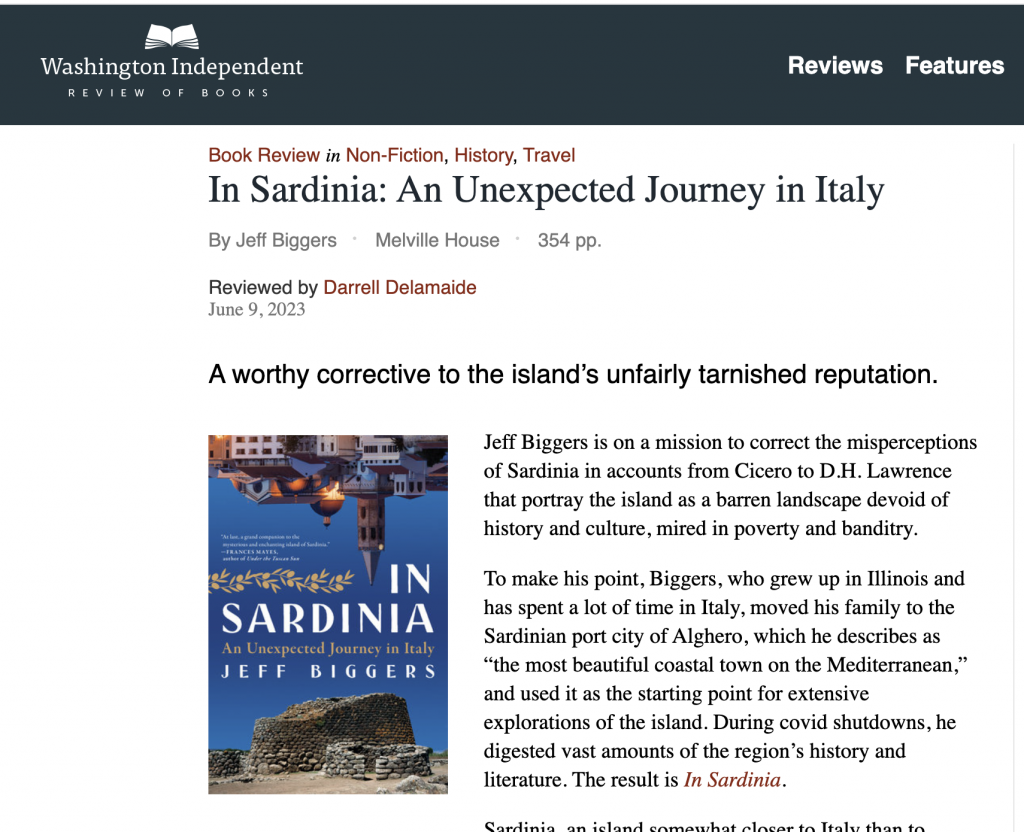
Book Review in Non-Fiction, History, Travel
In Sardinia: An Unexpected Journey in Italy
- By Jeff Biggers
- Melville House
- 354 pp.
- Reviewed by Darrell Delamaide
- June 9, 2023
A worthy corrective to the island’s unfairly tarnished reputation.
Jeff Biggers is on a mission to correct the misperceptions of Sardinia in accounts from Cicero to D.H. Lawrence that portray the island as a barren landscape devoid of history and culture, mired in poverty and banditry.
To make his point, Biggers, who grew up in Illinois and has spent a lot of time in Italy, moved his family to the Sardinian port city of Alghero, which he describes as “the most beautiful coastal town on the Mediterranean,” and used it as the starting point for extensive explorations of the island. During covid shutdowns, he digested vast amounts of the region’s history and literature. The result is In Sardinia.
Sardinia, an island somewhat closer to Italy than to Spain, is now one of the former’s autonomous regions after nearly four centuries under Spanish rule. It is very near Corsica, the birthplace of Napoleon that is now part of France, and not far from Sicily or Tunisia.
Europe’s multiple layers of history are visible to the most casual observer, and this is especially true of Italy. Biggers dives into this history to provide a portrait of the island that reflects these layers, pausing throughout his narrative to analyze Sardinia’s past.
“How does a field or plain show the aftermath of plagues and climatic disruptions, of invasions, of colonial occupations and wars and deployments of its men in foreign wars?” he asks during one of these pauses. “I wondered how we could understand the gross mismanagement by absentee landlords and landlords that had plundered the land of its forests, and eventually altered thousands of years of tradition by partitioning the land
with [stone] walls that ended the open grazing and seasonal movement of shepherds to open pastures.”
Biggers is especially taken with the Nuraghe, primitive stone towers that dot the island as evidence of a flourishing megalithic culture. These prehistoric edifices, similar to England’s Stonehenge and menhirs elsewhere in Europe, are unique to Sardinia; most are still awaiting proper excavation. The author’s enthusiasm for them is infectious, though readers not quite as fascinated by archeological remains might tire of his repeated descriptions. Fortunately, he doesn’t alight in any one place for too long.
The book is a successful and well-written blend of history, travel, art, literature, and culture, and it is probably no accident that it’s called In Sardinia, as Biggers extols Bruce Chatwin and his famous In Patagonia. “Instead of following a linear script of his journey across Argentina, Chatwin’s work followed the literary digressions of a wanderer, reflecting the restlessness of his own curiosity and the lives of those he met, especially immigrants,” he writes. “Chatwin described it as somewhere between ‘the narrative of an actual journey and a symbolic one.’”
While Biggers doesn’t actually embrace Chatwin as a model, he doesn’t disavow him, either. He is much less enamored of an earlier “traveling writer,” D.H. Lawrence, whose 1921 Sea and Sardinia projected the famed novelist’s often unfavorable impressions of the island on generations of readers. (Lawrence was not a happy camper despite his frequent voyages. He had some very unkind observations about Switzerland when he took a walking tour of Italy prior to World War I, as recounted in his Twilight in Italy.)
Sardinia nowadays is known to tourists primarily for it beaches, but Biggers doesn’t spend much time sunbathing. Rather, he is more interested in exploring the mountainous interior and the rich cultural history of the island. The author is determined to counter wrong impressions of these hills and embarks on a discussion of the various definitions of barbarians and the bad reputation Sardinia’s mountains have acquired among many, starting with writers in ancient Rome:
“All of these depictions — let’s call them calumnies of barbarism — were not merely filed away in the ancient chronicles like epithets. The image of the ill-clad plundering highlander remained a prototype for the next two thousand years. The historical sources of conflict in the region were rarely discussed.”
Biggers sprinkles his account with references to writers whose works are not translated into English; drops the names of greater and lesser Italian luminaries with a connection to Sardinia (did you know the father of Italy’s first female prime minister, Giorgia Meloni, was from there?); and doesn’t leave out the island’s many cultural achievements, from poetry to multimedia art.
The biggest drawback to In Sardinia, which limits its use as a travel guide, is its lack of extensive maps and an index. While there are compendious bibliographic notes, there’s only one simple map; a reader who wants to consult the book when visiting the island would have trouble finding his way around. Photos would be nice, too, making it easier to visualize Nuraghe and other sites (I used Wikipedia). None of that, however, detracts from the author’s accomplishment in compressing a rich account of a complex region into a readable, enjoyable book.